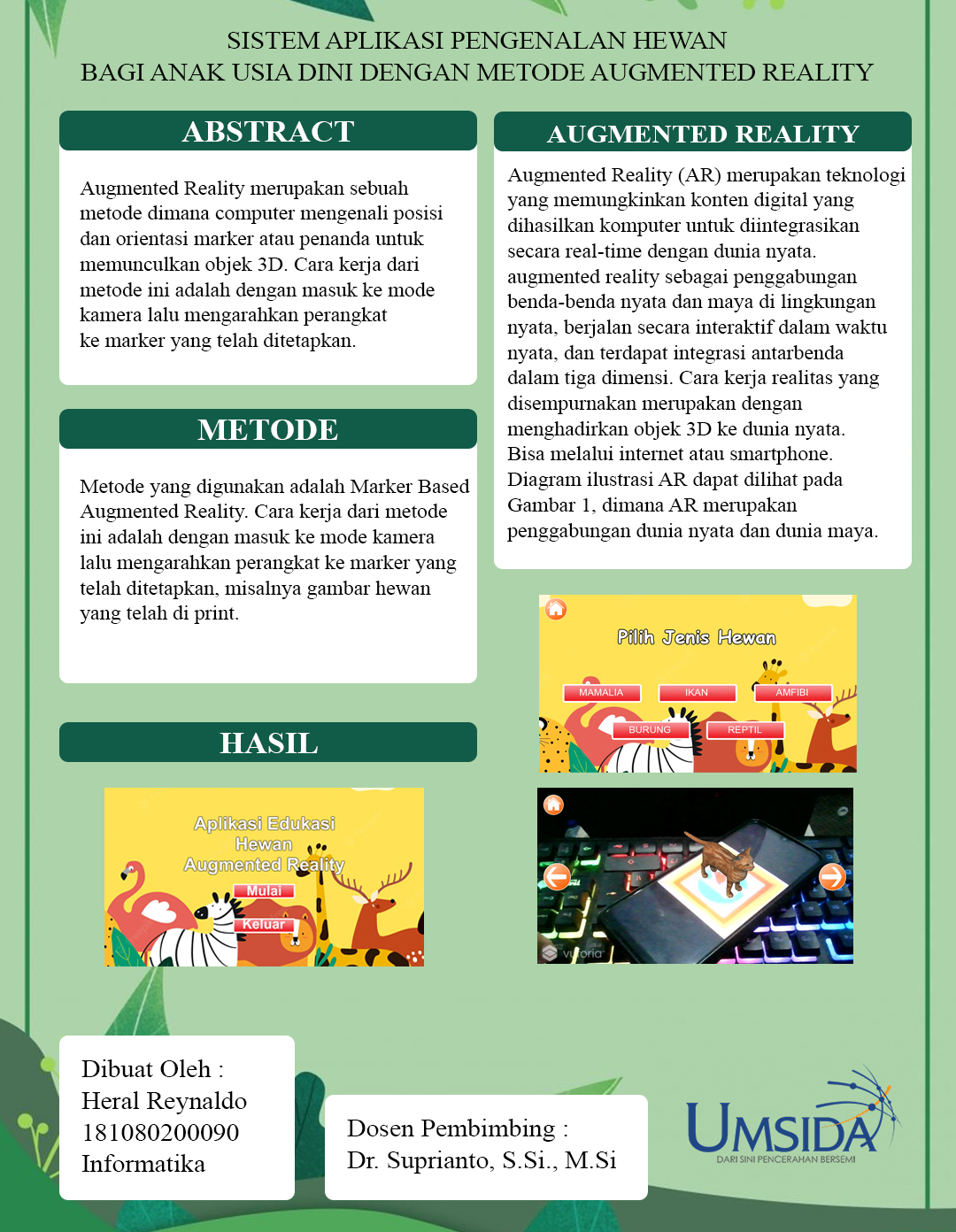Animal Recognition Application System for Early Childhood Using Augmented Reality Method
Sistem Aplikasi Pengenalan Hewan Bagi Anak Usia Dini Dengan Metode Augmented Reality
DOI:
https://doi.org/10.21070/pels.v2i2.1252Keywords:
Animal Recognition Application, Augmented Reality, Early Childhood, Marker BasedAbstract
Currently the level of interest in reading in children is very low. They prefer to play gadgets rather than reading books to add insight and knowledge. By reading, they can see and understand the contents of the reading. Especially learning about various animals around the world, not those around the house or surroundings, which they may not recognize. The aim of the researcher is to help children to learn about the animals around them and the world. Instead of children just playing with gadgets, it's better if their gadgets are used as learning tools. The marker-based Augmented Reality (AR) method is used as a method of recognizing the animal, because it can provide an overview of 3D visual objects that can provide information to make it more attractive to children. And AR is able to provide appropriate information in the real world. This is because Augmented Reality can provide interactive and more efficient learning, because children not only learn theoretically, but also see objects being taught in 3 dimensions. In the study, it can be seen that Augmented Reality can be used as a medium for introducing animals around the house and the world, it is hoped that this application can then be developed for various platforms and can also contain more information about all animals in the world.
Downloads
References
Apriyani, M. E., Huda, M., & Prasetyaningsih, S. (2016). Analisis Penggunaan Marker Tracking Pada Augmented Reality Huruf Hijaiyah. JURNAL INFOTEL - Informatika Telekomunikasi Elektronika, 8(1), 71. https://doi.org/10.20895/infotel.v8i1.54
Azuma, R. T. (2001). Augmented reality: Approaches and technical challenges. … of Wearable Computers and Augmented Reality.
Funny Farady Coastera, A. R. E. (2014). Rancang Bangun Aplikasi Informasi Universitas Bengkulu Sebagai Panduan Pengenalan Kampus Menggunakan Metode Markerless Augmented Reality Berbasis Android. Jurnal Teknik Informatika, 7(2), 63–71. https://doi.org/10.15408/jti.v7i2.1944
Haller, M., Billinghurst, M., & Thomas, B. (2006). Emerging Technologies of Augmented Reality, 2006. IGI Publishing, Hershey, PA, USA.
Iskandaria. (2012). Contoh Pengujian Black Box. http://kafegue.com/contohpengujian-black-box-testing/
M. Destiningrum and Q. J. Adrian, “Sistem Informasi Penjadwalan Dokter Berbassis Web Dengan Menggunakan Framework Codeigniter (Studi Kasus: Rumah Sakit Yukum Medical Centre),” J. Teknoinfo, vol. 11, no. 2, p. 30, 2017, doi: 10.33365/jti.v11i2.24
Mita Widiastiti, N. L. G., & Sastra Agustika, G. N. (2020). Intensitas Penggunaan Gadget Oleh Anak Usia Dini Ditinjau Dari Pola Asuh Orang Tua. Jurnal Pendidikan Anak Usia Dini, 8(June), 112–120.
Nursalina, A. I., & Budiningsih, T. E. (2014). Hubungan Motivasi Berprestasi Dengan Minat Membaca Pada Anak. Educational Psychology Journal, 3(1), 1–7.
R. Roedavan. Unity : Tutorial Game Engine. Informatika Bandung. 2016.
Shihab. 2011. Metode White Box dan Black Box Testing. http://rijjasihabuddin. blogspot.com/2014/03/metode-white-box-dan-black- box-testing.html.




